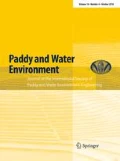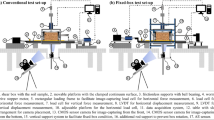Abstract
Repairs of concrete irrigation channels in Japan are guided to a large extent by the degree to which their walls have degraded over decades of use. Current methods of estimating Manning roughness coefficients from the roughness of the channel wall are based on linear profiles of arithmetic mean roughness. This study developed a method to estimate Manning roughness coefficients for a planar region directly from the peak-to-peak value of a reflected aerial ultrasonic wave, using a transceiver-based ultrasonic device. Model channel experiments using manufactured materials of known roughness were undertaken to confirm the strong correlation between peak-to-peak values and Manning roughness coefficients and to derive a conversion equation that was incorporated in the ultrasonic device. The device yielded Manning roughness coefficients for handmade concrete panels that matched estimates made by a conventional moulage gauge technique. It also matched the results of estimates by the commonly used Manning–Strickler equation. A field experiment in an operating irrigation channel confirmed these results, showing that aerial ultrasonic measurements of surface roughness are as accurate as those by existing techniques.











Similar content being viewed by others
References
Arcenebt Jr. GJ, Verne RS (1989) Guide for selecting Manning’s roughness coefficients for natural channels and flood plains. United States Geological Survey Water-Supply Paper 2339, pp 1–38
Hasegawa Y, Sai K, Sato S (2015) Proposal for estimation method on roughness coefficient of open canal in hydraulic experiment. J JSIDRE 83(2):125–128
Kato T, Honma S, Kitamura K, Imaizumi M (2008) Deterioration of irrigation canals and change in roughness coefficient. Technical report of the National Institute for Rural Engineering, vol 207, pp 183–193
Mohammad RI, Nagaoka S, Okajima K, Ishiguro S, Ito R, Watanabe K, Ito T (2016) Effects of hand made plastic horn to measure the arithmetic mean roughness of concrete surface by transceiver type aerial ultrasonic sensor. In: Proceedings of the 15th PAWEES conference 49
Nagaoka S, Okajima K, Ishiguro S, Kofuru T (2015) Comparison of transmitter and receiver types in measurement of the concrete surface roughness by the aerial ultrasonic sensor. In: Proceedings of the 2015 annual meeting of JSIDRE, pp 676–677
Nagaoka S, Mohammad RI, Okajima K, Ishiguro S, Ito R, Watanabe K, Ito T (2017) Measurement of arithmetical mean roughness of concrete by transceiver type aerial ultrasonic sensor. Int J Geomate 13(39):61–66. https://doi.org/10.21660/2017.39.52281
Nagaoka S, Mohammad RI, Okajima K, Ito R, Watanabe K, Ito T (2018a) Evaluation of attenuation of ultrasonic wave in air to measure concrete roughness using aerial ultrasonic sensor. Int J Geomate 14(42):158–163. https://doi.org/10.21660/2018.42.7242
Nagaoka S, Okajima K, Mohammad RI, Ito R, Watanabe K, Ito T (2018b) Influence of wind velocity on measurement of concrete surface roughness using aerial ultrasonic sensor. Trans JSIDRE 307:I_197–I_204. https://doi.org/10.11408/jsidre.86.I_197
Nakaya T, Tokashiki M, Mori M, Mori T (2008) Estimation of the coefficient of roughness from surface characteristics of abraded concrete channel. Trans JSIDRE 258:23–28. https://doi.org/10.11408/jsidre2007.2008.501
Okajima K, Nagaoka S, Ishiguro S, Ito R, Watanabe K, Ito T (2016) Measurement of the roughness of the concrete surface by the peak to peak value of the aerial ultrasonic wave. Trans JSIDRE 303:I_233–I_240. https://doi.org/10.11408/jsidre.84.I_233
Otagaki K, Hasegawa Y, Suzuki T, Matsumoto S, Sato S (2012) Study on measurement method of surface roughness of concrete canal by three dimensional image processing. Trans JSIDRE 280:311–317. https://doi.org/10.11408/jsidre.80.311
Strickler A (1923) Some contributions to the problems of the velocity formula and roughness factor for rivers, canals, and closed conduits. Mitteilungen des Eidgenössischer Amtes für Wasserwirtschaft, Bern
Takemura T, Tanji H, Araragi Y (2001) Study on a method to estimate coefficients of roughness. J Agric Eng Soc 69(5):25–28. https://doi.org/10.11408/jjsidre1965.69.5_477
Uchida K, Ishida M, Ogawa S (2008) Estimation of the coefficient of roughness for irrigation canals by transcription method for concrete surface. In: Proceedings of the 2008 annual meeting of JSIDRE, pp 432–433
Acknowledgements
The authors would like to thank Tokai Regional Agricultural Administration Office, Ministry of Agriculture, Forestry and Fisheries for the study field offer with an operating irrigation channel.
Author information
Authors and Affiliations
Corresponding author
Rights and permissions
About this article
Cite this article
Okajima, K., Nagaoka, S., Islam, M.R. et al. Development and testing of a surface roughness measurement device based on aerial ultrasonic reflections. Paddy Water Environ 18, 345–353 (2020). https://doi.org/10.1007/s10333-019-00786-3
Received:
Revised:
Accepted:
Published:
Issue Date:
DOI: https://doi.org/10.1007/s10333-019-00786-3




